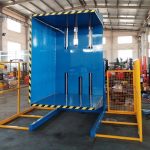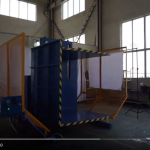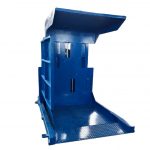How to Maximize ROI on Pallet Inverter Investments
In the fast-paced world of logistics and material handling, efficiency is king. One piece of equipment that's been making waves in recent years is the pallet inverter. These nifty machines can flip, rotate, and transfer loads with ease, saving time and reducing the risk of product damage. But like any investment, the key to success lies in maximizing your return on investment (ROI). In this comprehensive guide, we'll explore how to get the most bang for your buck when it comes to pallet inverters.
Understanding Pallet Inverters: More Than Just a Flip
Before we dive into ROI strategies, let's take a moment to appreciate what pallet inverters can do. These versatile machines are designed to rotate entire pallet loads 180 degrees. But that's not all - they can also:
- Transfer loads between different pallet types
- Safely handle unstable or damaged loads
- Replace damaged pallets without manual restacking
- Clean or sanitize pallets for hygiene-sensitive industries
Understanding the full range of capabilities is crucial for maximizing your investment. It's not just about flipping pallets; it's about revolutionizing your entire material handling process.
Assessing Your Needs: The Foundation of Smart Investing
The first step in maximizing ROI is ensuring you're investing in the right equipment for your specific needs. Here's how to conduct a thorough assessment:
Analyze Your Current Operations
- Volume: How many pallets do you handle daily?
- Load types: Are your loads uniform or varied?
- Pallet types: Do you use standard pallets or a mix of styles?
Identify Pain Points
- Where are the bottlenecks in your current process?
- Are you experiencing product damage during handling?
- How much time is spent on manual pallet transfer or restacking?
Project Future Needs
- Is your business growing? How will your needs change in the next 3-5 years?
- Are there new regulations or customer requirements on the horizon?
By thoroughly understanding your needs, you can avoid over-investing in unnecessary features or under-investing in a machine that can't keep up with demand.
Choosing the Right Pallet Inverter: Features that Boost ROI
Not all pallet inverters are created equal. Here are some key features to look for that can significantly impact your ROI:
Versatility
- Multi-function capabilities: Can it handle inverting, transferring, and de-palletizing?
- Adjustable settings: Look for machines that can handle various load sizes and weights.
Speed and Efficiency
- Cycle time: Faster cycle times mean more pallets processed per hour.
- Automated features: Look for options like automatic clamping and positioning.
Safety Features
- Load stabilization: Ensures products stay secure during rotation.
- Operator safety guards: Protect your most valuable asset - your employees.
Durability and Maintenance
- Construction quality: Robust builds mean less downtime for repairs.
- Easy-access maintenance points: Simplifies routine upkeep.
Remember, the cheapest option isn't always the most cost-effective in the long run. Investing in quality and versatility can pay dividends over time.
Integration Strategies: Seamless Workflow for Maximum Efficiency
A pallet inverter is only as good as its integration into your existing workflow. Here's how to ensure smooth incorporation:
Placement is Key
- Identify bottlenecks: Position the inverter where it can alleviate existing slowdowns.
- Consider traffic flow: Ensure easy access for forklifts and other equipment.
Training and Standard Operating Procedures (SOPs)
- Comprehensive training: Ensure all operators are fully versed in the machine's capabilities.
- Develop clear SOPs: Standardize processes to maximize efficiency and safety.
Workflow Redesign
- Optimize surrounding processes: Look for opportunities to streamline tasks before and after the inverter.
- Consider automation: Can the inverter be part of a larger automated system?
Proper integration can multiply the efficiency gains from your pallet inverter investment.
Maintenance and Upkeep: Protecting Your Investment
Regular maintenance is crucial for longevity and consistent performance. Here's how to keep your pallet inverter in top shape:
Preventive Maintenance Schedule
- Daily checks: Train operators to perform quick visual inspections.
- Weekly maintenance: Lubrication and minor adjustments.
- Monthly deep cleans: Thorough cleaning and more detailed inspections.
Staff Training on Basic Maintenance
- Empower operators: Teach them to handle minor maintenance tasks.
- Troubleshooting skills: Train staff to identify and report potential issues early.
Professional Service Agreements
- Regular professional inspections: Consider service contracts for expert maintenance.
- Quick response times: Ensure your provider offers prompt service to minimize downtime.
Remember, a well-maintained machine is a productive machine. Don't skimp on upkeep if you want to maximize ROI.
Measuring Success: KPIs for Pallet Inverter Performance
You can't improve what you don't measure. Here are some key performance indicators (KPIs) to track:
Productivity Metrics
- Pallets processed per hour: Compare before and after installation.
- Labor hours saved: Calculate the reduction in manual handling time.
Quality Improvements
- Reduction in product damage: Track incidents of damage during handling.
- Pallet quality improvements: Monitor the condition of pallets after transfer.
Financial Metrics
- Operating costs: Compare energy consumption and maintenance costs.
- Labor cost savings: Calculate the reduction in overtime or temp labor needs.
Safety Metrics
- Reduction in workplace injuries: Track incidents related to manual pallet handling.
- Near-miss reports: Monitor potential safety issues.
Regularly reviewing these KPIs will help you quantify your ROI and identify areas for further improvement.
Leveraging Technology: Smart Features for Enhanced ROI
In today's digital age, even pallet inverters are getting smarter. Here's how technology can boost your ROI:
IoT Integration
- Real-time monitoring: Track usage, cycle times, and maintenance needs.
- Predictive maintenance: Use data to anticipate and prevent breakdowns.
Automated Reporting
- Performance dashboards: Get instant insights into your inverter's performance.
- Compliance tracking: Automatically log data for regulatory requirements.
Integration with Warehouse Management Systems (WMS)
- Streamlined workflow: Coordinate inverter operations with overall warehouse activities.
- Inventory tracking: Automatically update inventory status as pallets are processed.
Investing in these smart features can provide valuable insights and further streamline your operations.
Cost-Saving Strategies: Maximizing Efficiency, Minimizing Expenses
While the initial investment in a pallet inverter can be significant, there are several strategies to reduce ongoing costs:
Energy Efficiency
- Optimize cycle times: Adjust settings to balance speed and energy use.
- Idle time reduction: Implement auto-shutoff features during downtime.
Multi-Shift Utilization
- Maximize usage: If possible, run the inverter across multiple shifts to spread the cost.
- Balance workload: Distribute pallet inverting tasks evenly to avoid peaks and valleys.
Bulk Supply Purchases
- Consumables: Buy pallet wrap, lubricants, and other supplies in bulk.
- Spare parts: Keep common replacement parts on hand to reduce downtime.
Cross-Training Employees
- Flexibility: Train multiple employees on inverter operation for better coverage.
- Reduced specialized labor: Minimize the need for dedicated operators.
By implementing these strategies, you can significantly reduce the total cost of ownership and boost your ROI.
Future-Proofing Your Investment: Adapting to Changing Needs
The world of logistics is ever-evolving. Here's how to ensure your pallet inverter investment stays relevant:
Scalability
- Modular designs: Look for inverters that can be upgraded or expanded.
- Flexible configurations: Choose models that can adapt to different pallet sizes or load types.
Industry Trends
- Stay informed: Keep an eye on emerging trends in pallet design and material handling.
- Regulatory changes: Anticipate future compliance requirements that may affect your operations.
Sustainability Considerations
- Energy efficiency: As energy costs rise, efficient models become more valuable.
- Recyclable materials: Consider the long-term environmental impact of your equipment.
By thinking ahead, you can choose a pallet inverter that will continue to provide value for years to come.
Case Studies: Real-World ROI Success Stories
Let's look at some real-world examples of companies that have maximized their ROI on pallet inverters:
Food Distribution Company
- Challenge: High rates of product damage during manual pallet transfer.
- Solution: Implemented a high-speed pallet inverter with load stabilization.
- Result: 85% reduction in product damage, 30% increase in throughput.
Pharmaceutical Manufacturer
- Challenge: Strict hygiene requirements for pallet sanitation.
- Solution: Invested in a pallet inverter with integrated cleaning system.
- Result: 50% reduction in labor costs, 100% compliance with sanitation standards.
E-commerce Fulfillment Center
- Challenge: Inefficient handling of mixed pallet types from various suppliers.
- Solution: Deployed a versatile pallet inverter capable of handling multiple pallet styles.
- Result: 40% increase in processing speed, significant reduction in workplace injuries.
These case studies demonstrate the transformative power of well-implemented pallet inverter solutions.
Conclusion: Investing in Success
Maximizing ROI on pallet inverter investments is about more than just choosing the right machine. It's about understanding your needs, integrating the equipment effectively, maintaining it diligently, and continuously looking for ways to improve.
By following the strategies outlined in this guide - from thorough needs assessment and smart feature selection to ongoing performance measurement and cost-saving tactics - you can ensure that your pallet inverter becomes a powerhouse of productivity in your operation.
Remember, the true value of a pallet inverter lies not just in its ability to flip pallets, but in its potential to transform your entire material handling process. With the right approach, your pallet inverter can become a cornerstone of efficiency, safety, and profitability in your logistics operations.
Invest wisely, implement thoughtfully, and watch as your pallet inverter delivers returns that go far beyond the balance sheet. In the world of logistics, where every second and every cent counts, a well-optimized pallet inverter can be the key to staying ahead of the competition and driving your business forward.









